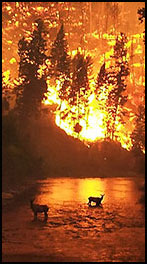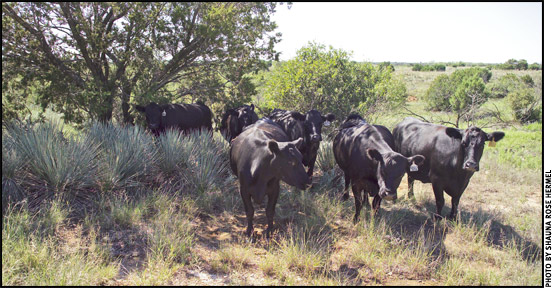Researchers Find Clues to
Explain Effects of Heat Stress
"Biology of heat stress" could lead to new strategies for managing heat stress in livestock.
News headlines for the summer of 2011 tell a dismal story:
"Heat hits farmers …"
"USDA lowers milk production forecast …"
"Bleak message to cattle producers …"
Record heat waves hit across the United States, leaving animal producers wondering how to deal with heat stress in their herds. Heat stress can kill animals, but even non-life-threatening temperatures can be devastating. Animals eat less and produce less milk or meat. Agricultural production suffers, and the world is left with less food.
"It's a billion-dollar issue in the American dairy industry alone," said Lance Baumgard, the Norman Jacobson Endowed Professor of Nutritional Physiology at Iowa State University. "It's a food security issue in many developing countries."
Baumgard has been working with Virginia Tech animal scientist Robert Rhoads to learn more about how heat stress affects animals. Baumgard and Rhoads have found that loss of appetite due to heat stress is not the only reason animals become less productive. A rise in insulin levels and changes in energy metabolism are also important. Read more.

Richard Dyar
Association Perspective
Association helps serve commercial partners.
Angus bull buyers are not just buyers; they are our partners. We, the American Angus Association and our membership (Angus breeders), work very hard to earn and keep our commercial partners' business.
We realize serving your seedstock needs as a commercial cattleman is the benchmark for most of what we do. That's why the Association has so many programs geared to helping the commercial producer. Read more.
 The Feedlot's Footprint
The Feedlot's Footprint
We won't argue whether global warming is occurring as a result of the buildup of "greenhouse gases" largely attributable to the combustion of fossil fuels and other human activity. We can agree that lawmakers are under pressure to adopt climate change legislation. That's enough to focus attention on the so-called carbon footprint of all industries, including agriculture.
According to Environmental Protection Agency (EPA) statistics, agriculture is responsible for only 6.4% of all U.S. greenhouse gases. Still, because domestic livestock are responsible for about half of agriculture's share, livestock production comes under considerable scrutiny. Since 65% of livestock emissions are attributed to beef cattle, the beef industry must seem an easy target of criticism. Read more.
Minneapolis Zoning Supports Urban Farming
Minneapolis ordinance now in place that allows more opportunities to grow food.
Mayor R.T. Rybak and the Minneapolis City Council March 30 adopted a zoning code change that allows expanded food growing to occur in the city. The zoning code text amendment approves two new land uses — for market gardens and urban farms — and sets development and design standards. Minneapolis already allows community gardens in most areas of the city and there were more than 100 of them in place last year.
Under the new code, regulatory barriers are removed that make it difficult to establish land uses for agriculture in the city. Urban agricultural land uses are now expanded in all zoning districts to include: Read more.
Lawmakers, Livestock Groups Raise Concerns with Animal Production Mandates
NCBA president says federal mandate on livestock production compromises animal welfare.
Lawmakers and representatives from animal agriculture joined forces to educate nearly 100 people about the deliberate emphasis farmers and ranchers place on caring for the health and well-being of their animals. During a briefing hosted by Congressmen Adrian Smith (R-Neb.) and Joe Courtney (D-Conn.), congressional staff learned about multiple voluntary animal care programs and about the concerns farmers and ranchers have with legislation introduced in the House that would mandate strict on-farm production practices. Read more.
What’s Inside …
In this April edition of the Angus Beef Bulletin EXTRA, you'll find valuable articles devoted to the management, marketing, and health and nutrition of your beef enterprise. Select from the tabs at the top of the page to access this month's entire offering by category. A few select features include:
- One-two Punch
- Understanding AUMs
- Controlling Feed Costs
- Digital Dermatitis
- Looking for Ways to Control Leptospirosis
- Education Needed About LFTB
- Beef Consumers and Flavor
News Briefs …
The American Angus Association and its subsidiaries generate a wealth of information to keep members and affiliates informed of what's happening within the industry as well as with the programs and services they offer. Click here for easy access to the newsrooms of the American Angus Association and Certified Angus Beef LLC and the Angus e-List archive.
 Fire Risk Potential
Fire Risk Potential
Report indicates fire risk from April to July.
Fire can be a useful tool when used appropriately and planned accordingly. However, wildfires can be a disaster to homes, farms/ranches and pastures. Natural disasters are never predictable, but, luckily, in the case of wildfires, previous weather patterns do give producers more of a heads up than normal.
The National Wildland Significant Fire Potential Outlook, released by the National Interagency Fire Center, is a good tool to use to predict fire hazards for your area. The major factors affecting the outlooks are La Niña/El Niño, drought and fuel dryness. This outlook is for the time period between April through July. Read more.
Respiratory Protection on the Farm and Ranch
Farmers and ranchers often work in areas where air quality can be less than ideal. Agricultural producers working in such conditions should wear personal protective equipment (PPE) to decrease their risk of contracting a respiratory impairment. Individuals who should use respiratory protection are those working around dust, mold spores, silage, fish meal, agricultural chemicals, solvents and toxic gases in confined animal housing.
Respiratory hazards fall into one of three categories:
1. Particulate contaminants: Dusts, mists and fumes contaminate the air with particles that can be inhaled.
2. Gases and vapors: Gases are chemicals that are gaseous at room temperature, such as those found in silos and manure pits. Vapors are released from liquid applications, such as pesticides and adhesives.
3. Oxygen-deficient atmosphere: Oxygen levels can be almost as low as 5% in such areas as sealed silos, manure storage facilities and controlled atmospheric storage for fruits and vegetables.
Your respiratory protective equipment must be properly fitted for you, designed for the job that you need to complete, and specific to your work environment. A single type of respiratory protection does not fit all work situations, so it is critical to identify the appropriate type of respiratory protective equipment for each situation. Read more.
[Click here to go to the top of the page.]













